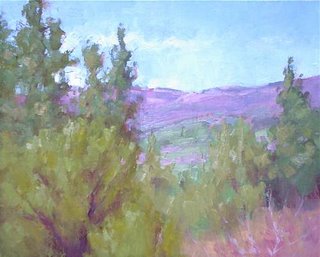In the ongoing search for a new panel, I tried making my own panels -- 1/8" hardboard from Guerrilla Painters and "traditional gesso" from Gamblin. Traditional gesso is rabbit hide glue, gypsum and titanium dioxide, and Gamblin has added marble dust for texture. The drawback of this product is the rabbit hide glue -- you have to heat the mixture in a double-boiler and apply it hot. As you work with it, you have to periodically re-heat the mixture, otherwise it gets too thick to apply.
A perhaps bigger drawback is that the foundation you apply the gesso to must be rigid. Even the 1/8" hardboard may not be rigid enough to keep the gesso from cracking if the board should flex. When I painted the below painting, even though it was on an 8x10 panel, which shouldn't flex much, I detected cracks. Oddly, I couldn't see the cracks when the panel was dry, but when I applied my initial underpainting, I could see cracks quite clearly.

I sanded the surface lightly with fine steel wool prior to painting. The sanding didn't remove the marble dust texture, which is a good thing.
The solution to these two headaches is, of course, acrylic gesso. You don't have to heat it and it won't crack because the acrylic forms a somewhat flexible film.
Again, as with the Gessobord, this surface is very absorbent. A coat of medium prior to painting would be ideal.
(And still, not a bad painting!)



